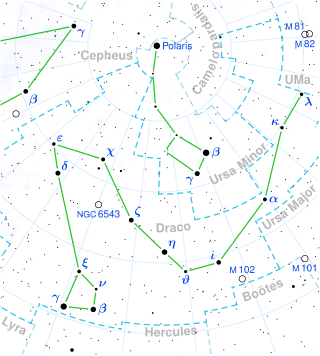
Thuban, with Bayer designation Alpha Draconis or α Draconis, is a binary star system in the northern constellation of Draco. A relatively inconspicuous star in the night sky of the Northern Hemisphere, it is historically significant as having been the north pole star from the 4th to 2nd millennium BC.

Radio Television Hong Kong (RTHK) is the public broadcasting service in Hong Kong. GOW, the predecessor to RTHK, was established in 1928 as the first broadcasting service in Hong Kong. As a government department under the Commerce and Economic Development Bureau of the Hong Kong Government that directly supported by annual government funding, RTHK's educational, entertainment, and public affairs programmes are broadcast on its eight radio channels and five television channels, as well as commercial television channels.

Alpha Librae is a double star and, despite its 'alpha' designation, it is the second-brightest star system in the constellation of Libra. The two components are designated α1 Librae and α2 Librae. The system bore the traditional name of Zubenelgenubi, though the International Astronomical Union now regards that name as only applying to α2 Librae.

Eta Virginis is a triple star system in the zodiac constellation of Virgo. From parallax measurements taken during the Hipparcos mission it is about 265 light-years from the Sun. It has a combined apparent visual magnitude of 3.89, bright enough to be seen with the naked eye in dark skies.

Epsilon Geminorum or ε Geminorum, formally named Mebsuta, is a star in the constellation of Gemini, on the outstretched right 'leg' of the twin Castor. The apparent visual magnitude of +3.06 makes it one of the brighter stars in this constellation. The distance to this star can be determined by parallax measurements, giving a value of 840 light-years, with a margin of error of 40 ly (12 pc).

Beta Virginis, a name Latinised from β Virginis, is a star in the equatorial constellation of Virgo. It has the proper name Zavijava, and, despite its designation 'beta', is the fifth-brightest star in Virgo with an apparent visual magnitude of 3.604. The distance to this star is 35.7 light-years based on parallax, and it is drifting further away with a radial velocity of +4.1 km/s. It is 0.69 of a degree north of the ecliptic, so it can be occulted by the Moon and (rarely) by planets. The next planetary occultation of Beta Virginis will take place on 11 August 2069, by Venus.

The Hong Kong Space Museum is a public astronomy and space science museum located in Tsim Sha Tsui, Hong Kong. Opened on 8 October 1980, it is managed by the Leisure and Cultural Services Department of the Hong Kong Government. The building is notable for its hemispherical shape, which contains a planetarium, the only one in Hong Kong. The main facilities of the museum are located in a building next to the planetarium, showcasing information about the Solar System, cosmology, and spaceflight.

Theta Aquarii, officially named Ancha, is a star in the equatorial constellation of Aquarius. Visible to the naked eye at apparent magnitude 4.175, it is located at a distance of around 187 light-years from the Sun. Since it is near the ecliptic it can be occulted by the Moon, or very rarely by planets.

Mu1 Scorpii (μ1 Scorpii, abbreviated Mu1 Sco, μ1 Sco) is a binary star system in the southern zodiac constellation of Scorpius. The combined apparent visual magnitude of the pair is about magnitude 3, making it one of the brighter members of Scorpius. Based upon parallax measurements, the distance of this system from the Sun is roughly 500 light-years (150 parsecs). This system is a member of the Scorpius–Centaurus association, the nearest OB association of co-moving stars to the Sun.

Omicron1 Eridani, also named Beid, is a variable star in the constellation of Eridanus. With an average apparent visual magnitude of 4.04, it is visible to the naked eye on a clear, dark night. Based upon parallax measurements, it lies approximately 122 light-years from the Sun.

Kappa Virginis, officially named Kang, is a solitary star in the zodiac constellation of Virgo. It has an apparent visual magnitude of 4.18, which is sufficiently bright to be seen with the naked eye. Based upon stellar parallax measurements, the distance to this star is about 255 light-years.

Lambda Draconis, also named Giausar, is a solitary, orange-red star in the northern circumpolar constellation of Draco. It is visible to the naked eye with an apparent visual magnitude of +3.85. Based upon an annual parallax shift of 9.79 mas as seen from the Earth, the star is located around 333 light years from the Sun.

Alpha Equulei, officially named Kitalpha, is a star in the constellation of Equuleus. It is a high proper-motion star only 190 light-years away.

Hong Kong Arts Centre is a non-profit arts institution and art museum established in 1977. It promotes contemporary performing arts, visual arts, film and video arts. It also provides arts education. Its rival is the government-managed Hong Kong Museum of Art. These two museums are considered to be the top two art museums in Hong Kong that dictate the discourse of art in Hong Kong.
The Hong Kong Federation of Youth Groups is a non-profit organization in Hong Kong, committed to develop youth services. Founded in 1960, the Federation has since been involved in providing activities and facilities for the physical, social, educational, cultural development of Hong Kong's youth.
Pakistanis in Hong Kong are an ethnic minority in Hong Kong. According to Home Affairs Department, there are 24,385 Pakistani people live in Hong Kong constituting 4% of the population based on the 2021 census. According to the 2016 Official Census this population was then 18,094. In the 2011 census, 17,253 people were Pakistani nationals, and the number decreased to 15,234 in the 2016 census

"Glory to Hong Kong" is a protest song that was composed and written by a musician under the pseudonym "Thomas dgx yhl", with the contribution of a group of Hongkonger netizens from the online forum LIHKG during the 2019–2020 Hong Kong protests. It was initially written in Cantonese and was eventually developed into various language versions starting with English.

Culture, Sports and Tourism Bureau (CSTB) is one of the fifteen policy bureaux of the Hong Kong Special Administrative Region. The bureau is responsible for the policy portfolios of culture, sports and tourism. The agency was established on 1 July 2022. The current Secretary for Culture, Sports and Tourism is Kevin Yeung.

Christine Choi Yuk-lin, is the current Secretary for Education in Hong Kong, formerly the principal of Fukien Secondary School and vice-chairlady of Hong Kong Federation of Education Workers.















